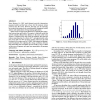Free Online Productivity Tools
i2Speak
i2Symbol
i2OCR
iTex2Img
iWeb2Print
iWeb2Shot
i2Type
iPdf2Split
iPdf2Merge
i2Bopomofo
i2Arabic
i2Style
i2Image
i2PDF
iLatex2Rtf
Sci2ools
POPL
2007
ACM
2007
ACM
Locality approximation using time
Reuse distance (i.e. LRU stack distance) precisely characterizes program locality and has been a basic tool for memory system research since the 1970s. However, the high cost of measuring has restricted its practical uses in performance debugging, locality analysis and optimizations of long-running applications. In this work, we improve the efficiency by exploring the connection between time and locality. We propose a statistical model that converts cheaply obtained time distance to the more costly reuse distance. Compared to the state-of-the-art technique, this approach reduces measuring time by a factor of 17, and approximates cache line reuses with over 99% accuracy and the cache miss rate with less than 0.4% average error for 12 SPEC 2000 integer and floatingpoint benchmarks. By exploiting the strong correlations between time and locality, this work makes precise locality as easy to obtain as data access frequency, and opens new opportunities for program optimizations. Categories ...
Compilers General Terms | Data Access Frequency | POPL 2007 | Programming Languages | Reuse Distance |
| Added | 03 Dec 2009 |
| Updated | 03 Dec 2009 |
| Type | Conference |
| Year | 2007 |
| Where | POPL |
| Authors | Xipeng Shen, Jonathan Shaw, Brian Meeker, Chen Ding |
Comments (0)

